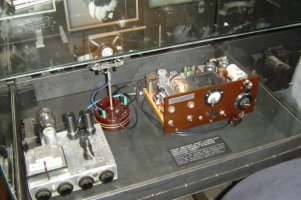
Replica of the radio station "Burza"
The Uprising's phonic radio stations and technical resources
When relating the events of the Warsaw Uprising 1944, we normally think of the courageous line soldiers fighting on the barricades, arms in hand.
However, one must also be mindful of the unshaken presence and tremendous effort exerted by the soldiers in the technical field, where harsh conditions prevailed, but who ensured the fighters as well as the civilian population in the Srodmiescie were supplied with power and water. Their relentless endeavours guaranteed the efficiency of the meager arms supplies and their ingenuity and unconventional solutions allowed these to be replenished.
One must be aware of the fact that the Uprising would, surely, never have lasted as long as it did, were it not for their efforts.
It is only with great difficulty that the present day reader can envisage the situation facing the people of Warsaw during Hitler's occupation and especially the Uprising of 1944. During the time which has elapsed since then, a major revolution in the information field has taken place. Radio, ground and satellite television, internet, radio and mobile phones provide readily available information, even to the point of superfluity. Not so long ago, information was controlled and censured and a land-line was a difficult-to-attain luxury. And a steady stream of electric power, heating gas and running water are a fact.
In the middle of last century, during the gloomy days of the 40's occupation, the situation was entirely different, both in the Polish countryside and in the Polish capital, the German-occupied Warsaw. Information regarding the situation in the country and on the war fronts was limited. The only official information came from the German Armed Forces' news bulletins and in the apposite texts found in the official occupation press (Kurier Waszawski, "gadzinowka: - a propagandist Nazi newspaper in Polish).
The real information was obtained by listening to the British BBC, which also aired in Polish, using illegal radios, (on occupying Warsaw, the Germans demanded radios be turned-in) or through the underground Polish press, which was distributed under threat of death. (e.g. the Information Bulletin published by the AK Headquarters' Office for Information and Propaganda (BliP KG AK).
The possession or distribution of such information carried the penalty of prison, concentration camp or even death.
To a limited extent, conspiratorial groups (partisan or acting within city structures) used the radio telegraph communication system. The less powerful conspiratorial short wave transmitters were adapted to transmitting and receiving coded signals, using the Morse alphabet. Using ground waves, the maximum range was 15 km. in open areas and 2-3 km. in built-up ones. Communication over longer distances required the use of the wave reflection system, where the signal could be received up to at least a few hundred kilometres and was dependent on weather conditions and the time of day (wave deflected from the ionosphere). For this purpose, radio communication centres were set up in Barnes Lodge, Stanmore, England and in Masagne near Brindisi in Italy. Books containing the codes were delivered by couriers. At the very beginning of the conspiratorial work, orders were conveyed solely by liaison people. Contact with the government in London was kept up by using only a few radio stations, by couriers who crossed the border of the Generalna Gubernia (German-occupied Poland) illegally, by parachuting into special areas or by being moved in by plane onto secret landing sections as part of the "cichociemni" operation. (the silent dark ones - a secret unit of the Polish Army in exile created to maintain contact with occupied Poland ).
During the Warsaw Uprising 1944, the situation was just as complicated. The insurgent groups fighting in the various isolated districts communicated with one another by way of liaison officers. The same system was used between commanders and linesmen to communicate orders and reports. Communication between the various districts was even more complicated. Sometimes it was possible to use the still existent city telephone network and in other cases liaison officers were used and they often had no choice but to use the sewage canals.
Information on weapon drops for fighting Warsaw were broadcast from London by the BBC, using coded signals, and were picked up at monitoring points. They were quite simply fragments of melodies. The AK headquarters kept in contact with London by way of a few field radio stations.
For reasons previously discussed, radiotelegraph communication between the various districts took place via England and Italy, which prolonged the information exchange time.
The communication deficiency was the cause of many a bungled action. A classical example was the insurgents' unsuccessful attack on the Dworzec Gdanski on 15-16 August 1944. It was assumed the two detachments would attack simultaneously; "Zywiciel" from Zoliborz and "Radoslaw" from Stare Miasto. The lack of a satisfactory communication system meant the insurgent groups did not attack synchronously. Their successive efforts were ineffectual in face of the enemy's fierce fire. The insurgents sustained heavy losses (hundreds dead and wounded) and the entire operation ended up in fiasco.
The Uprising's radio stations
During the Uprising, two AK high-capacity phonic radio stations were working in Warsaw, the "Blyskawica" and the "Burza."
In 1943, a member of the Polish Association of Radio Amateurs, who had escaped from a prisoner of war camp, Antoni Zebik, pseudonym "Biegly" from Czestochowa began to assemble parts to build a more powerful phonic radio station, which could establish contact with London. In May 1943, a representative of the AK Signal Army Commander, lieutenant engineer Czeslaw Brodziak, pseud. "Adler," coordinated the technical details with the designer and the radio station was assembled in Boleslaw Drozdz's attic with his avid participation.
On 1 September 1943, the transmitter was put into service. Audibility was good on 7 MHz in the country and on 10 MHz in England. The Germans tried to hunt down the radio station but, fortunately, it was taken on a hay wagon to a secret place. On 31 December 1943, it was brought to Warsaw and hidden in a car workshop on Huculska Street in Mokotow. Named "Blyskawica," it was the AK Headquarters' Office for Information and Propaganda phonic radio station during the Warsaw Uprising.
On the day of the outbreak of the Uprising, it turned out that "Blyskawica" was not in working order having been wrongly stored and damp parts. It required a few days maintenance work. Due to the prevailing circumstances, the Government Delegacy's Radio Communication Inspector, Maj. Stanislaw Noworolski, pseud. "Zwora" gave instructions that a second, similar phonic radio station be built as quickly as possible. The young radio amateur, Wlodzimierz Markowski, was chosen for the job. Work on "Burza" began on 2 August 1944 in the afternoon, in two rooms belonging to the Main Post Office on Napoleon Square (pl. Powstancow Warszawy - Insurgents' Square) and sub groups, which had been in author Juliusz Kaden-Bandrowski's house on Boduen Str., moved in. Markowski drew a sketch of the transmitter from memory. A plank cut out from a wardrobe acted as the base and the main sheet, made of bakelite, was attached to it. On 3 August in the afternoon, the transmitter was ready for use. Only the aerials were missing. That evening Maj. Noworolski brought a suitable line and, by using the two masts already on the building, it was possible to erect a 30m high aerial. Around midnight, tuning work on the transmitter began and two hours later the first test audition went out.
The technical operator, programme editor and speaker were rolled into one, Wlodzimierz Markowski. The bulletins were from the "Information Bulletins" BliP KG AK. The 15-30 minute transmission period was followed by a few minutes of news pertaining to the actual situation in the city. This included the search for lost persons, the need to provide support, requests and appeals for foreign help for fighting Warsaw. "Burza" transmitted thrice daily, at 10:00, 14:00 and 17:00. London confirmed the programme's audibility.

Replica of the radio station "Burza"
In the meantime, on 8 August 1944, Lieut. engineer Czeslaw Brodziak, "Adler" and a team of radio technicians got the radio station "Blyskawica" working. It was located in the PKO (bank) building on the corner of Swietokrzyska and Jasna Str. The Polish Radio also made use of it. "Blyskawica" broadcasted four times daily, at 9:45, 14:00, 19:30 and 22:00 on short wave 32.8m (9.2 MHz) and 52.1m (5.8 MHz). The length of the transmission depended on the amount of material available and did not exceed one hour.
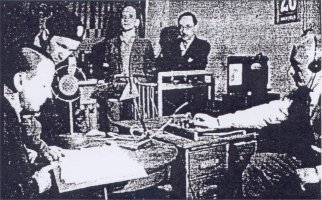
"Blyskawica" in the PKO (bank) building, 20 August 1944
Sabotage programs for the Germans were aired on medium wave 224m (1.3 MHz). The "Blyskawica" chief of propaganda was Stanislaw Zadrozny, "Pawlicz," his deputy, Zofia Rutkowska, "Ewa" and the lead speaker Zbigniew Swietochowski, "Krzysztof." Polish Radio broadcasted at 10:55 on short waves and 18:30 on medium ones. " Burza" worked simultaneously broadcasting its own regular programmes and repeating the "Blyskawica" ones on wave length 52.1m. Both transmitters kept in constant contact with the radio headquarters in Great Britain and southern Italy.
At the end of August, the Germans traced "Burza" with the use of pelengaters. For a number of days, the building housing the Main Post Office was bombarded by German planes. On 26 August "Burza" was destroyed. At the AK Headquarters' Chief of Staff's recommendation "Blyskawica" was moved to the restaurant "Adria" at 10 Moniuszko Str.
During the fierce fighting on the Powisle, the Germans had been systematically destroying the power plant there and when they occupied the plant premises on 5 September, the city was, once and for all, divested of electricity. On the instructions of the AK Headquarters, soldiers from the group "Chwaty" transferred "Blyskawica" to the Srodmiescie-South where it was located in an outbuilding behind premises at 13 Poznanska. A medium wave radio transmitter, accumulators, converters and a radio-technical workshop were situated in the "Adria."
In the night 5 to 6 September, the AK Main Headquarters also moved to Srodmiescie-South, Pius XI Str., into the building where the Polish Joint Stock Telephone Company was (Mala Pasta).
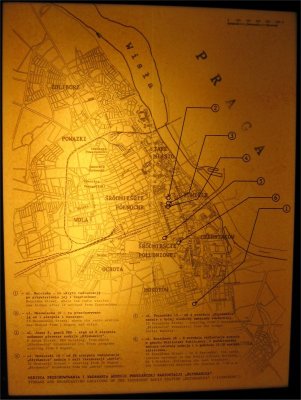
"Blyskawica's" successive locations in Warsaw
In its new abode, "Blyskawica" was powered by electricity from the Uprising's field power plant at 51 Hoza Str. It was initiated and run by Capt. Michal Bucza's, "Mechanik" soldier sappers. "Blyskawica" was quickly uncovered by the Germans and, on 8 September, a German plane nose-dived and bombed the building in which it was located. Fortunately, the apparatus escaped damage and the radio station was promptly taken to the building behind the Public Library at 21 Koszykowa Str. where it continued to function until 4 October. It continued to be powered by electricity from 51 Hoza Str. On the evening of 4 October 1944, "Blyskawica" broadcasted for the last time and was destroyed.
Power Plant
It must be remembered that the radio station continued functioning after the destruction of the power plant in Powisle because of the Uprising's field power plant. The history of its initiation and functioning is not only fascinating but also one without precedence, just as is the launching and working of "Burza" and "Blyskawica."
In the west part of Srodmiescie-South, in the region of the streets Emilia Plater, Wspolna, Poznanska, St. Barbara, Zulinski, Nowogrodzka, Marszalkowska, Wilcza and Hoza was where the "Zaremba" group operated. It was then transformed into the "Piorun" battalion. The detachment was created on the basis of the Guard Company Headquarters of the AK VII Warsaw Precinct, "Obroza," which was located on the premises of the Dairy and Egg Products Co-op Society at 51 Hoza Str.
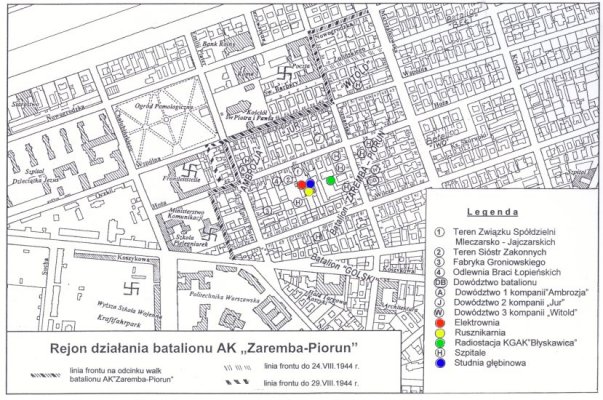
The "Zaremba-Piorun" battalion's area of activity.
After a few days of battle, it was obvious the Uprising was not going to be over quickly. There was a genuine fear that the Germans would cut off the water and power supplies to the city. A decision was made to build a field power plant at 51 Hoza Str. and activate a deep-water well.
Capt. Michal Bucza, "Mechanik", commander of the "Obroza" sappers was given the task. The soldiers were also required to make explosives and manufacture and repair arms.
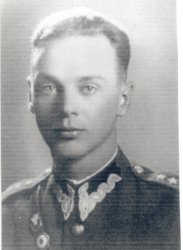
Capt. Michal Bucza, "Mechanik"
Engineer Sobieslaw Dajkowski, "Florek" was in charge of all work regarding the building of the power plant and later its commander. He was an electrician and an electric machine construction specialist.
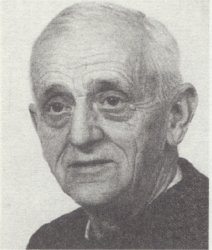
Engineer Sobieslaw Dajkowski, "Florek"
A 15 kVA current-generating aggregate, "Phaenomen," was brought from the not-too-big repair shop on Poznanska Str. It had, most probably, been brought there by the Germans to be repaired. Before the Germans occupied the Polytechnic, "Florek" and his people had managed to remove the generator and much electrical equipment from the premises. A car engine and generator had been taken from the Strojwas business at 57 Hoza Str. "Florek" installed a reserve overhead power connection from one of the transformers on the Polytechnic premises on the Koszkowa Str. side. It was powered directly from Pruszkow.
"Phaenomen" was installed in a relatively small room in the main warehouse cellars and made ready to supply the electric pump for the deep-water well. It produced three-phase alternating current, voltage 380/220V. This meant the receiving power plants and the remaining ones working on 220V could also be supplied. The Groniewski crane factory at 10 Emilia Plater Str., working for the gunsmithery, utilised the power for its machine tools as did the Lopienski Brothers' foundry, producing shells for hand grenades at 55 Hoza Str.
After 20 August 1944, the Srodmiescie-South area was divested of electricity from the power station on Powisle and of water from the city water mains. The reserve power line form the Polytechnic was in German hands and had also been disrupted. In the meantime, the current-producing aggregate was put into service, so providing the insurgents and civilian population with some power. The deep- water well was also supplied.
At the same time, work was begun on a second aggregate using a car engine together with a generator brought from the Polytechnic premises. The aggregate also had 15 kVA. Both worked without reciprocal synchronisation. Apart from the previously mentioned recipients, power was supplied to a network of hospitals in the area, with around 300 beds, and an x-ray unit. The hospitals dealt with more than 1,500 wounded.
During the first few days, the power plant was run by four soldiers: commander engineer Sobieslaw Dajkowski, "Florek," Corp. Jozef Zielonka, "Gryf," and soldiers, Tadeusz Baczynski, "Damian," and Henryk Kuligowski, "Michal." As it worked round the clock, it required a lot of petrol. This was carried in canisters from distant places in Srodmiescie-North and from German warehouse tanks located around Trzech Krzyzy Sq. and Ksiazeca Str.
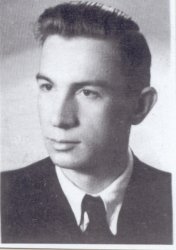
Soldier Tadeusz Baczynski, "Damian"
On 5 September, after transferring the AK Main and District Headquarters to Srodmiescie-South, the phonic radio station, "Blyskawica," was hooked up to the field power plant. It was first located at 13 Poznanska Str. and then at 26 Koszykowa Str. Apart from it, the District Command radio station, the Area Command radio station 02 "Anna" info-radio outpost and radio stations 09 and 09A used it too. Additionally, the K2 reporting depot equipment was supplied by it. It monitored radios, coded and decoded telegrams round-the-clock.
After the collapse of the municipal power plant on the Powisle, a few of its workers from the "Krybar" group got through to the Srodmiescie-South. Among them were the following soldiers: Hieronim Borkowski, "Pogon," Zdzislaw Kwiecinski, "Skuliga" and Stanislaw Ryszkowski, "Weglarz." They considerably reinforced Capt. "Mechanik's" power plant staff.
Work in the plant was extremely difficult and carried much responsibility. The plant operated 24 hours a day. The current-generating aggregates' internal combustion engines worked non-stop in the narrow confines of the cellar. The temperature inside exceeded 50oC.The engine fumes and the din made the long-lasting shifts strenuous and exhausting. This meant that in September, in this part of the city, you could not hear the droning of the heavy German mortars, "cow" or "sheep," or the air raid bombings, or the shelling from the heaviest railroad guns. You could only feel the earth trembling, a result of the explosions.
Capt. "Mechanik's" field power plant at 51 Hoza Str continued functioning up till 5 October 1944, even after the Uprising capitulated. Although most of the civilian population had departed the city, there were still the wounded, old and infirm, who could not leave on their own, in the surrounding hospitals and houses. Power and water were indispensable for them. A group of fitter-operators, Capt. "Mechanik's" soldiers, remained by the aggregates. They obtained attestations from the Polish Red Cross that they were acting as nurses.
The power plant ceased functioning on 5 October 1944 and the Germans removed its aggregates to Sochaczew.
Water supply
In order to be able to utilise the deep-water well at 51 Hoza Str., certain modifications had to be made to the water distribution system. In order to supply the armory, the pipes from pumps were connected to those inside the buildings, at the same time cutting them off from the street pipes. A week later this makeshift situation was substituted by pipelines from the water-tower. Tubs for melting butter, found on an upper floor, were used for this purpose. This pipeline supplied the armory and provided the civilian population with, at least, 40,000 litres of water daily. Every day, at a specific time (during the least firing), crowds of people queued up in the courtyards of 13 Poznanska Str. for water. More than 30,000 people benefited from this source.
The organised distribution of water worked well. In spite of tensions rising beyond endurance, the public maintained order, up until the end of the Uprising. This was indeed due to the well-organised personnel and disciplinary services. Shameful scenes occurred sporadically and were quickly eliminated thanks to the positive attitude of the people.
A provisional over ground pipeline system was also installed. It supplied water to the nearby lying properties, providing the civilian population there with access to water. Street springs were set up on the property inhabited by the nuns at 53 Hoza Str., on the property at 13 Poznanska Str. by the wall bordering with "Jajczarnia" (51 Hoza Str.) and on the corner of 51 Wilcza and Poznanska Str. Most people gathered at the water point at the back of 13 Poznanska, bordering with the property at 49 Hoza Str. As this location was not protected by buildings, a large tub, made from a sheet of metal, was placed under the tap enabling the people to draw water quickly, thus not having to remain for longer periods of time at a location, often under heavy fire. Pipelines were also run to field hospitals and the more important command points.
The arms plant and gunsmithery
Capt. Michal Bucza, "Mechanic," commander of the sappers, organized a technical unit at 51 Hoza Str., named after the commander's pseudonym, "Capt. Mechanik Group." The technical lieutenant, engineer Anatol Kicinski, "Spawacz" worked closely with the above group.
And so "the factory' came into being. Here, arms were repaired, explosive materials produced and grenades and howitzers manufactured.
Almost from the first day of the Uprising, incendiary bottles and grenades were being produced. Platoon leader Stanislaw Gladysz, "Jarema" was in charge of the few women from WSK (Women's Army Service) who were involved in their production.
Casting furnaces from the Lopinski Brothers factory at 55 Hoza Str. were used to manufacture the hand grenade shells. The shells and moulds were produced by a worker from the Wilga factory. Zinc was melted down in the factory's special earthen furnaces. After the supplies were used up, zinc was obtained from the roofing of destroyed homes. The hand grenades were also made from water pipes, which were stuffed with home made explosive materials or with the unexploded German rounds.
The premises of the "Jajczarnia" at 51 Hoza Str. housed supplies of Norway saltpeter, saltpetre and a well-equipped chemical laboratory. Saltpetre, being a strong oxidant, was combined with powdered sugar so producing a mixture, which increased its volume when burned and produced enormous pressure. The explosive material so produced was called cheddite, with similar properties to trotyl. The sugar was ground in high-performance electric mills brought from the Strojwas factory. At first the igniters were gun powder fuses with or without detonators. Later another type was produced. These consisted of a glass tube attached inside the grenade with another glass tube, closed at both ends and pinched in the middle and filled with concentrated sulphuric acid. A certain amount of igniters and explosive materials were obtained from the AK Main Headquarters' warehouses. Later the igniters were also produced by themselves under the direction of engineer Eugeniusz Zochowski, "Eugeniusz."
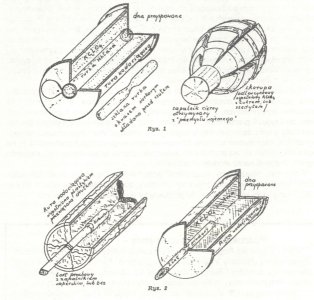
Sketches depicting the construction of the grenades produced
Between 200 and 300 grenades of this type were produced in twenty-four hours. Working with explosive materials was extremely dangerous. Within the first few days of the Uprising, 3 women from Capt. "Mechanik's' group landed in the hospital at 61 Wilcza Str. with wounds and burns incurred during the manufacture of grenades. Soldier Jadwiga Chrzaszczewska-Suchodolska died from her wounds on 8 August 1944.
Apart from their self-manufactured explosive materials, it was also obtained from unexploded German shells. The removing of igniters and the winning of explosive material from unexploded shells was highly dangerous.
Hand grenade shells were produced in the Lopienski Bros.' foundry for coloured metals at 55 Hoza Str., using the factory's casting furnaces. The factory had a relatively small supply of zinc, about 200kg, which was used to start the shell production. The forms and the moulds were made by a factory employee, Mr. Wilga. The zinc was smelted in special earthen furnaces and after the supply was depleted, the zinc was obtained from the roofs of destroyed buildings. These types of grenade were completed and filled with explosive materials in the main warehouse, at 51 Hoza Str. where the Dairy and Egg Products Co-op Society, "Jajczarnia" and the gunsmithery were located. The assembled grenades were distributed to their own fighting groups and to others in the Srodmiescie-South. During the Uprising, several thousands of different types of grenades were produced in this "Factory."
On 5 August, engineer Mieczyslaw Lopuski, "Konstruktor," suggested to "Mechanic" that they work together on the grenade production. The initial attempts with grenade launchers, based on the cross-bow principle, were not successful. "Konstruktor" came up with a design for a howitzer made from pipeline and operating on the principle of a normal howitzer. The design was accepted and "Konstruktor" brought in Kazimierz Schodowski, "Kizior," Antoni Wojdowicz and Jan Wrzolka to work in the "Factory."


Lieutenant Mieczyslaw Lopuski, "Konstruktor" Kazimierz Schodowski, "Kizior"


An Uprising howitzer produced in the "Factory"
Machines from the Groniewski crane factory at 10 Emil Plater Str. were used to machine-finish the howitzers. From a steep track, the howitzers ejected grenades, also made from pipeline, but of a smaller diameter, which could cover several hundred metres causing panic amongst the Germans. Whilst trying to improve the howitzer, "Konstruktor" was seriously injured and lost a hand. He was replaced by engineer Eugeniusz Zochowski, "Eugeniusz." 25 howitzers were produced.
The "Factory" also attempted to produce flame-throwers. To this purpose, garden sprinklers, syringes and pumps were appropriately converted. Unfortunately, they did not function satisfactorily as the petrol consumption was too high and the firing range too short and so further tests were abandoned.
On the very first day of the Uprising, technical officer, lieutenant engineer Anatol Kicinski, "Spawacz," organised a weapon repair shop, taking advantage of the Milk Association's mechanical workshops at 51 Hoza Str. This gunsmithery, where arms were repaired, worked round the clock until mid August 1944. During the first 3 weeks of the Uprising the number of repaired weapons exceeded the number of weapons held by the VII precinct. This confirmed the fact that, had there been no gunsmithery, the section would have been defenceless.
During the first half of the Uprising only repairs for the V11 precinct were undertaken here. In the second half, further outlying fighting sections were served and included weapons from weapon drops.
The repairs mainly involved acetylene welding and brazing. And so expeditions to Czerniakow or Zelazna to obtain oxygen (carbide was plentiful) became just as important as those for ammunition, weapons or food.
The gunsmithery on Hoza carried out a number of different jobs. Weapons, which had been dug out of the earth, were made functional including some heavy-type submachine guns, "Maxim". These had been dug up on the Pola Mokotowskie under the pretext of potato picking. Faulty parts were removed, springs and pins were made and parts fitted, including those from Stens and Piats, which had been dropped. Weapons faulty due to wear and tear were also repaired. Corroded cartridge cases were soldered, using brass. Weapons, which had been shot through or broken, were repaired. New butt-ends, made of steel piping, were affixed. Missing or broken sighting apparatus was replaced or fixed. Machine gun, type "Blyskawica," also had their lock handles replaced or fixed. Repairs were undertaken on weapons intentionally damaged by the Germans, who often removed an important part of the weapon before discarding it. The missing part had to be replaced without a draught and often without any knowledge of it at all.
Towards the end of the Uprising, the gunsmithery received damaged weapons from the Soviet army drops. They were dropped from a not too great height and without the use of parachutes from biplanes "kukuryznik" (a single-engined biplane used, by the Russians before the war, to spray maize/corn fields). In all, there were 9 howitzers, 6 armour-piercing rifles and 16 machine pistols of which 5 howitzers, 4 armour-piercing rifles and 7 machine pistols were repaired and given over to use in the last days of the Uprising. (Capitulation thwarted further repair). Stands for heavy machine guns were also produced here and a 37mm. small-calibre gun, from a burned-out tank was repaired and attached to the chassis. They were successful in converting sprinklers and syringes into provisional flame-throwers. Moreover, casting moulds were turned.
Of the 450 weapons which passed through the factory during the Uprising, only 1 was disqualified. It was a 7,62 rifle, the barrel of which was used to produce pistol barrels of the same calibre.
The above noted facts show how extensive was the effort of the soldiers involved in the technical resource field of the Warsaw Uprising.
A replica of the radio station, "Blyskawica" was created to honour the 60th. anniversary of the outbreak of the Warsaw Uprising 1944. The Committee for the Building of a Replica of the Uprising Radio Station, "Blyskawica" was initiated by Polish radio amateurs. The honorary patronage was held by the then president of the city and capital, Lech Kaczynski.
Contact was made with the designer of "Blyskawica," Antoni Zebik, living in Radomsk. An appeal went out to the radio amateurs, requesting help in finding parts from the 40's. Part of the transmitter was ready by 8 February 2004. Jan Nowak-Jezioranski offered recordings broadcasted by "Blyskawica" in 1944.
On 29 May 2004, a group of Warsaw radio amateurs installed the replica near Radzymin. Zygmunt Seliga (a member of the Association to the Memory of the Warsaw Uprising 1944 and a radio amateur) together with the operator, Sylwester Pielaszek carried out the first broadcasting attempts at 11:54 and 12:15. They turned out well and were confirmed by QSL cards.
On the anniversary of the outbreak of the Warsaw Uprising 1944 the radio station replica transmitted on 32.8 wavelength. This became a tradition in the following years.


Zygmunt Seliga getting the "Blyskawica" replica started
On 08 August 2006 at 09:45, Zygmunt Seliga had the phonic radio station "Blyskawica" replica running. It had been installed in The Museum of the Warsaw Uprising at 79 Grzybowska Str. The president of The Association of Warsaw Insurgents, Gen. Zbigniew Scibor-Rylski, pseud. "Motyl" read fragments from some of the original "Blyskawica" programmes, broadcasted on 8 August 1944. At that time, the speaker was Zdzislaw Swietochowski, "Krzysztof," from Polish Radio.
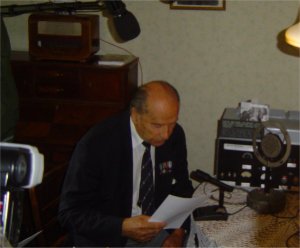
Gen. Scibor-Rylski reading a an announcement
"Hello! Here's "Blyskawica," the Home Army's radio transmitter in Warsaw on 38,2 and 52,1 metres. Warsaw's spirit is wonderful. The Warsaw ladies are wonderful. They're everywhere: up front with the soldiers or working as nurses or couriers..."
After the news the following words could be heard: "We greet all the people of the world who love freedom, Polish soldiers fighting in Italy and France, Polish pilots and sailors." The audition was completed with a rendering of the "Warszawianka."
The "Blyskawica" transmissions during the anniversary celebrations of the Warsaw Uprising 1944, as well as the daily 11:15 bugle-call, based on the Warszawianka theme, from the Royal Castle tower in Warsaw will become a part of tradition, in remembrance of the valiant moments experienced by Poland's capital.
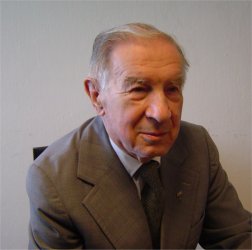
|
Material provided by: Rifleman, Tadeusz Baczyński "Damian" Battalion "Zaremba-Piorun" Capt. "Mechanik's" group Edited by: Maciej Janaszek-Seydlitz Translated by: Jolanta Siestrzewitowska |
Copyright © 2008 SPPW1944. All rights reserved.